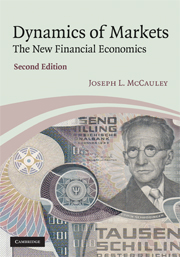Book contents
- Frontmatter
- Contents
- Preface to the second edition
- 1 Econophysics: why and what
- 2 Neo-classical economic theory
- 3 Probability and stochastic processes
- 4 Introduction to financial economics
- 5 Introduction to portfolio selection theory
- 6 Scaling, pair correlations, and conditional densities
- 7 Statistical ensembles: deducing dynamics from time series
- 8 Martingale option pricing
- 9 FX market globalization: evolution of the Dollar to worldwide reserve currency
- 10 Macroeconomics and econometrics: regression models vs empirically based modeling
- 11 Complexity
- References
- Index
10 - Macroeconomics and econometrics: regression models vs empirically based modeling
Published online by Cambridge University Press: 02 December 2010
- Frontmatter
- Contents
- Preface to the second edition
- 1 Econophysics: why and what
- 2 Neo-classical economic theory
- 3 Probability and stochastic processes
- 4 Introduction to financial economics
- 5 Introduction to portfolio selection theory
- 6 Scaling, pair correlations, and conditional densities
- 7 Statistical ensembles: deducing dynamics from time series
- 8 Martingale option pricing
- 9 FX market globalization: evolution of the Dollar to worldwide reserve currency
- 10 Macroeconomics and econometrics: regression models vs empirically based modeling
- 11 Complexity
- References
- Index
Summary
Introduction
The level of business activity depends strongly on the ease of obtaining money as credit, and the level of money should in principle be determined by central banks. However, central banks rely notoriously on models, and the economic models used have not been empirically deduced from observed time series. Rather, the models have been postulated, or “validated,” on the basis of regression analysis, while relying on an assumption of stationarity of economic variables. In later, more sophisticated treatments, the method of cointegration, which assumes stationary increments and also ergodicity, is used. The assumptions made by economists about the noise in the regression models cannot be justified empirically, and the models yield spurious predictions of stability.
Keynes stated that economic theory is used for creating and maintaining economic policy and models have been invented that support one brand of economic policy or another. Keynesian economics encouraged government intervention to try to fine-tune the economy from the Great Depression until at least the early 1970s. The emergence of rational expectations in the 1960s and beyond provided theoretical support for laissez faire policies (Bell and Kristol, 1981). Deregulation as policy has dominated in the USA and UK since at least 1981, and has spread worldwide on the advice of economists based on rational expectations theory. The aim here is to expose the holes in the rational expectations claims, and to see that that model does not provide any empirical basis for adopting laissez faire as policy.
- Type
- Chapter
- Information
- Dynamics of MarketsThe New Financial Economics, pp. 214 - 240Publisher: Cambridge University PressPrint publication year: 2009



